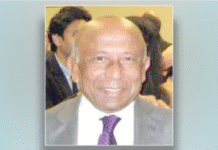Rupak Bhattacharjee
Bangladesh’s investigators now admit that the brazen attack on the Gulshan café, which left 22 people dead, including 20 foreigners, was orchestrated by an IS-affiliated new faction of the banned Jamaat-ul-Mujahideen-Bangladesh (JMB) or “Neo JMB”. The Bangladeshi intelligence agencies believe the mastermind of the Gulshan café attack, Tamim Ahmed Choudhury, is the leader of the “Neo JMB”. Bangladesh police claimed that they have identified at least seven people, including another key conspirator Nurul Islam Marzan, who played different roles in the Gulshan carnage along with Tamim. Investigations are on to learn more about Marzan, a drop out from Chittagong University. The security forces are also making efforts to apprehend renegade army Major Syed Ziaul Haque, who engineered the 2012 abortive coup against the Hasina government and some of the recent terror attacks in Bangladesh.
Various factions of JMB
Among all the radical Islamist groups active in Bangladesh, the JMB which first raised its ugly head in 2004 has emerged as the most potent threat to the country’s peace, security, stability and democracy. In the face of relentless crackdown by the law enforcement agencies, the JMB had split into different factions, one of which has recently re-surfaced in the form of “Neo JMB”. Local reports suggest that the JMB is currently divided into at least three factions. One is the old JMB, most of whose leaders were sentenced to death and subsequently executed. It now constitutes a very small faction. Tamim-led “Neo JMB”, which is composed of fresh recruits, is much stronger.
After 2013, the JMB has regrouped and gained strength with the merger of other Bangladeshi militant outfits. Reports say a few radical Islamist groups, including Ansar al-Islam and Hizb ut-Tahrir have integrated with the JMB. Some Bangladeshi security experts said the third JMB faction could be the one that has merged with the Ansar ul-Islam. It was earlier affiliated to Al-Qaeda, and Ansarullah Bangla Team (ABT) is its cyber identity used for training.
Emergence of “Neo JMB”, its operational tactics and IS linkages
Reports indicate that the new JMB faction has undergone a major transformation in its composition and terror strategy. The “Neo JMB” mainly consists of tech-savvy youngsters, but it also has some Madrassa students among its ranks. About a decade back, the JMB leaders used to recruit mostly Madrassa boys from rural and poor background, while the “Neo JMB” is quite different. The new recruits are primarily drawn from upper middle class or rich families, educated in elite schools having access to modern technology. This development has surprised Bangladesh’s security forces, who are finding it difficult to detect their motives and future plans.
The “Neo JMB” has also changed its operational tactics. It now prefers specific targets that are meticulously worked out. The “Neo JMB”, which had earlier carried out bomb attacks, is presently relying on machetes and sharp weapons and small arms to execute assassinations. Bangladesh’s top police officials observe that the rapid change in the global situation has in turn altered the tactics of the local radical Islamist outfits. The JMB militants have ruthlessly murdered more than 40 people, including “atheist” bloggers, writers, activists, intellectuals, publishers, foreigners and members of religious minority groups and sects since 2014.
The Bangladeshi intelligence organisations discovered the rise of “Neo JMB” led by Tamim – a Canadian-Bangladeshi – only after the country’s worst terror attack on July 1. They also suspect that Abu Ibrahim al Hanifa, who was appointed as the chief of IS’ Bangladesh unit some months back, is none other than Tamim. He heads the JMB faction that maintains close ties with the IS. This new faction or “Neo JMB” has no link to the old JMB, and has regrouped and re-organised itself under the leadership of Tamim. Bangladesh’s security experts maintain that the “Neo JMB” has been working for the IS and staging attacks with disturbing regularity to get recognition from the dreaded international terror group after demonstrating its credentials.
Propaganda devices and cyber warfare of “Neo JMB”
Amidst repeated terror strikes the “Neo JMB” has reportedly launched an IS-style news agency called Al Tamkin in Bangla, waging cyber warfare. Al Tamkin has been successfully blocked by Bangladesh’s cyber intelligence, but the “Neo JMB” militants have floated a Bangla version of IS-backed news agency Amaq. Reports say both can be accessed in neighbouring India. Through these two sites, the jihadists are feeding propaganda material designed to radicalise young Bengali Muslims in Bangladesh and bordering Indian states, including Bengal. Al Tamkin translated a long interview of IS’ Bangladesh chief al Hanifa into Bangla that was carried by Dabiq, the propaganda magazine of the IS. Al Tamkin’s mission statement says it wants to “carry the voice of the Khilafah to those who speak in Bangla”.
Concern over missing youths
Bangladesh has been witnessing a sudden spurt in radicalisation with several youths getting attracted towards jihadi ideologies and programmes over the last few years. The country’s security forces are trying to find out the whereabouts of hundreds of young men who are missing for over a year. Some of them are reported to be sons of retired or serving army officials, bureaucrats and businessmen. In the aftermath of the Gulshan attack, the AL government appealed to the families to contact authorities if their sons had disappeared.
Instructions were issued to all schools, colleges and universities to report to the authorities about the students who had been missing for several months. Bangladesh’s specially-trained security force Rapid Action Battalion (RAB) has released a list of 260 people missing from various parts of Bangladesh in the recent months. In its bid to control radicalisation, the AL government has been collecting information on youths reported missing for some time, as investigation revealed a trend of such youths joining jihadi groups.
Sweeping crackdown on jihadi elements
Facing criticism for not doing enough to combat Islamist militancy in the wake of continuous killing of bloggers, intellectuals, foreigners and religious minorities, the AL government has finally resolved to act firmly against the religious extremists and terrorists after the audacious attack on the Gulshan eatery. Counter-terrorism operations have been intensified throughout Bangladesh, with several militants either killed in encounters or apprehended by the security forces. On August 21, police shot dead two suspected militants when they tried to attack them at a check-point in northern Tangail district.
In the last few weeks, Bangladesh’s law enforcement agencies neutralised a number of hardcore JMB militants who posed a serious security threat to the country. In an encounter on August 3, top JMB militant Nurul Islam alias Bike Hasan, who is suspected to be involved in at least 11 killings and two other attempts targeting foreigners and religious minorities, was killed in northwestern Rajshahi city. In another major development on July 26, Bangladesh police killed nine suspected JMB militants in the capital city’s Kalyanpur area. Police claimed these alleged militants had been plotting a Gulshan café like attack.
Raihan Kabir alias Tarek, one of the nine JMB cadres shot dead by police during a special raid at Kalyanpur was the Dhaka region coordinator of the proscribed outfit and had trained the Gulshan attackers. The July 26 security operation was an important breakthrough as the intelligence agencies identified Tamim, believed to be in his mid 30’s, as the mastermind of the two back-to-back terror strikes – July 1 attack on the Gulshan café and assault on Eid congregation at Solakia in northern Kishoregaanj district six days later.
Following the July 1 terror attack, the security forces have also succeeded in apprehending at least 25 suspected militants mostly belonging to “Neo JMB” along with huge quantity of explosives, weapons and ammunition. Interestingly, among them, 11 were female activists of JMB. In another significant development on July 27, Bangladesh’s High Court upheld the capital punishment awarded to six JMB terrorists over deadly bombings in 2005 at a court that killed 8 people, including four lawyers. According to the prosecution, these militants detonated bombs at the Gazipur court premise on November 29, 2005.
AL government’s security talks with the universities
Bangladesh is worried about its educational institutions especially universities as they are emerging as breeding ground of radicalisation. Reports suggest that the students of North South University (NSU), BRAC University, and Scholastica School were among those who carried out the terror attack on Holey Artisan Bakery and O’ Kitchen. While attending a meeting with the administrators of public universities on July 14, Bangladesh Education Minister Nurul Islam Nahid asked the universities to identify teachers who are motivating students to join jihad. The meeting was organised after the investigation into the recent militant attacks revealed that some university students were running away from home and joining radical Islamist groups.
The Bangladesh government held another crucial meeting with authorities of all private universities on July 17. Currently, 80 private universities are functioning in the country. Many civil society groups raised security concerns after it was found that some of those involved in the recent militant attacks were from private universities. Two of the Gulshan attackers had been students of NSU. In 2015, an investigation team of Bangladesh’s University Grants Commission discovered jihadi books of terrorist outfit Hizb ut-Tahrir in the university library. Reports said several teachers and students of NSU were expelled for their links to militant outfits. Following the July 1 attack, police arrested the acting Pro-Vice Chancellor of NSU Professor M Gias Uddin Ahsan.
Challenges ahead
Despite all these counter-terrorism measures, militant attacks targeting innocent persons have not stopped. On July 17, three veteran Bauls (Sufi singers) were hacked in Chuadanga district. It appears that the jihadi groups are pushing hard to redefine the role of Islam in Bangladesh’s polity. The Islamic discourse in the country has already undergone a change in the recent years due to the intrusion of radical ideologies. Innumerable Madrassas pledging allegiance to Wahabi and Salafi schools of thought have been imparting radical Islamist teachings throughout the country. The civil society of Bangladesh is seriously concerned about growing religious intolerance and the radical agenda of the extremist and terrorist groups.
The Bangladesh government can not afford to lower its guard, as the jihadi threats loom large over the country. The IS has warned that violence would continue until the Islamic law is established across the world, saying in a video that the Gulshan attack was just a beginning. The non-stop killing of foreigners and minorities is aimed at creating political instability and choking the country’s much needed international development assistance. It is expected that the AL government will strictly enforce counter-terrorism measueres and combat Islamist violence which is corroding Bangladesh’s secular fabric. The issue of containing radicalisation is to be seen in the realm of democratic governance that still remains a challenge for the Hasina government.
Source: bdnews24










